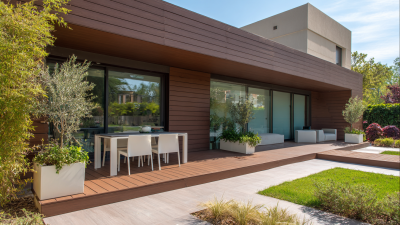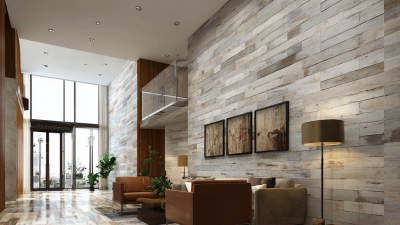Leave Your Message
In today's fast-paced world, homeowners are increasingly seeking sustainable yet stylish solutions for their interiors. One such innovative choice is the WPC wall panel interior, which combines the best of both aesthetics and environmental responsibility. Crafted from wood-plastic composite materials, these wall panels not only embody modern design principles but also help reduce the carbon footprint associated with traditional building materials. As designers and homeowners alike embrace eco-friendly options, WPC wall panels stand out for their versatility, durability, and ease of maintenance. Whether you're aiming for a sleek minimalist look or a warm, rustic vibe, these panels provide an ideal backdrop for contemporary living spaces. Join us as we explore how transforming your home with WPC wall panel interiors can elevate your design while supporting a greener planet.

Eco-friendly WPC (Wood Plastic Composite) wall panels are rapidly gaining popularity among homeowners looking to modernize their interiors while making sustainable choices. These panels are made from a blend of recycled wood fibers and plastic, providing a durable and weather-resistant option that is ideal for various applications within the home.
 Unlike traditional wood, WPC panels do not warp or splinter, making them a low-maintenance choice for busy households. Additionally, their aesthetic versatility allows for a range of design possibilities, whether you prefer a sleek, modern look or a more rustic feel.
Unlike traditional wood, WPC panels do not warp or splinter, making them a low-maintenance choice for busy households. Additionally, their aesthetic versatility allows for a range of design possibilities, whether you prefer a sleek, modern look or a more rustic feel.
The benefits of using eco-friendly WPC wall panels extend beyond durability and aesthetics. They are an excellent choice for environmentally conscious consumers, as they utilize recycled materials and contribute to reducing deforestation. By choosing WPC panels, homeowners can create beautiful interiors that not only enhance the living space but also reflect a commitment to sustainability. As the market for WPC wall panels grows, so too does the availability of innovative designs and applications, making it easier for individuals to find the perfect solution for their home renovation projects.
WPC (Wood Plastic Composite) wall panels have emerged as a transformative element in contemporary interior design, offering a blend of aesthetic versatility and eco-friendliness. With their unique composition, these panels are not only lightweight and durable but also available in a wide range of textures and finishes. This variety allows designers to create spaces that reflect personal style while maintaining a modern aesthetic. Whether you seek the natural warmth of wood or the sleek elegance of minimalist design, WPC wall panels cater to diverse preferences and harmonize with various decor themes.
The adaptability of WPC wall panels extends beyond their appearance; they also provide practical benefits that enhance modern interiors. Their resistance to moisture and decay makes them suitable for high-traffic areas, such as living rooms and kitchens, while their ease of installation simplifies renovation projects. Furthermore, the eco-friendly nature of WPC, made from recycled materials, aligns with the principles of sustainable design, making it an appealing choice for environmentally-conscious homeowners. By incorporating WPC wall panels, you can achieve a stunning aesthetic that is both stylish and responsible, seamlessly integrating modernity with sustainability.
This bar chart demonstrates the rising popularity of WPC (Wood Plastic Composite) Wall Panels in various interior design aesthetics over the last five years. The data highlights how these panels contribute to modern interior trends.
WPC (Wood Plastic Composite) wall panels have
emerged as a top choice for modern interiors, thanks to their remarkable durability and performance compared to traditional materials. According to a recent study by the American Wood Council, WPC materials can withstand extreme weather conditions and have a lifespan that exceeds 25 years with proper maintenance, making them an ideal choice for both indoor and outdoor applications. This longevity not only reduces replacement costs but also minimizes environmental waste.
The innovative design of WPC wall panels enhances their performance. They are resistant to moisture, pests, and UV rays, which are common threats to conventional wood products. Additionally, advancements in manufacturing processes have led to the creation of WPC products with reinforced structures, capable of offering extended spans and greater load-bearing capabilities. For instance, new products introduced in the market now incorporate structural elements that improve overall integrity and reduce thermal expansion concerns, positioning WPC as a leader in sustainable building materials that meet the demands of modern architecture.
WPC (Wood-Plastic Composites) wall panels present a compelling economic case for homeowners and builders seeking modern, eco-friendly solutions. While the initial investment in WPC panels might be higher than traditional materials, their long-term benefits outweigh the upfront costs. These panels are highly durable, resistant to moisture, and require minimal maintenance, which can significantly reduce repair and replacement expenses over time. Additionally, their energy-efficient properties contribute to lower heating and cooling costs, making them a wise financial choice for modern interiors.
Furthermore, the cost-benefit analysis of WPC wall panels considers their longevity and sustainability. By opting for these eco-friendly materials, consumers are not only investing in their homes but also in a greener future. The reduced environmental impact of WPC production compared to conventional wood panels enhances their appeal, while the aesthetic versatility allows homeowners to achieve stylish designs without compromising on quality. Ultimately, the economic viability of WPC wall panels showcases their potential to elevate modern interiors while providing lasting financial advantages.
| Feature | WPC Wall Panels | Traditional Wood Panels |
|---|---|---|
| Cost per Square Foot | $3.50 | $5.00 |
| Installation Cost per Square Foot | $2.00 | $2.50 |
| Lifespan (Years) | 25 | 15 |
| Maintenance Cost per Year | $100 | $200 |
| Environmental Impact (CO2 Emissions) | Low | Moderate |
| Water Resistance | Excellent | Poor |
| Fire Resistance | High | Variable |
| Return on Investment (ROI) over 10 years | 150% | 100% |
WPC (Wood Plastic Composites) wall panels are increasingly gaining traction in modern interiors, thanks to their aesthetic appeal and significant environmental benefits. These panels are made from recycled wood fibers and plastic, creating a product that not only reduces waste but also minimizes the reliance on traditional materials that may contribute to deforestation. By utilizing WPC, homeowners and builders contribute to sustainable construction practices that align with the growing demand for eco-friendly living spaces.
Tips for choosing WPC wall panels include considering the source of the materials, opting for products with certifications that guarantee sustainability, and ensuring that the panels are designed for long-lasting performance. Additionally, look for options that are easy to maintain, as this can further enhance their environmental appeal by reducing the need for chemical cleaners or treatments.
Incorporating WPC wall panels can also play a role in enhancing indoor air quality. Since these materials are designed to be low in emissions, they contribute to a healthier living environment. As urban areas grapple with increasing air pollution, selecting sustainable building materials like WPC becomes a crucial strategy in reducing the overall environmental impact of residential buildings.








